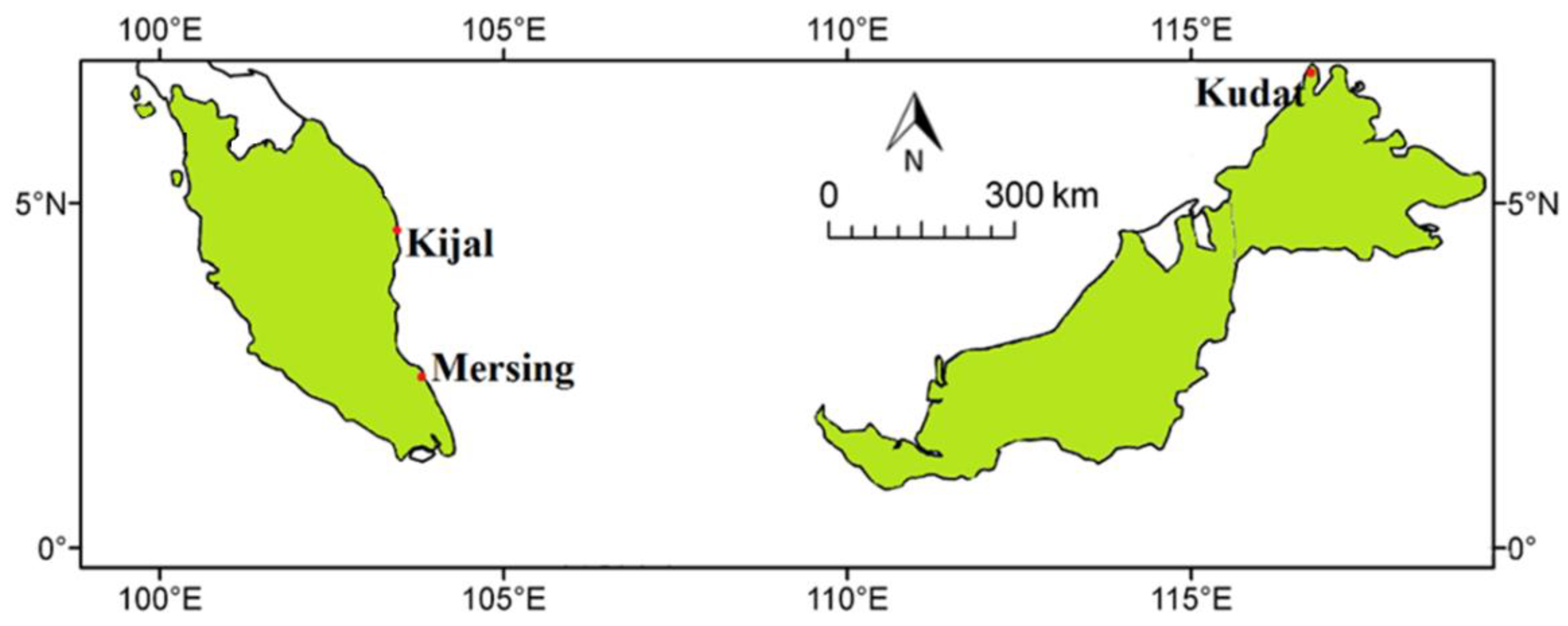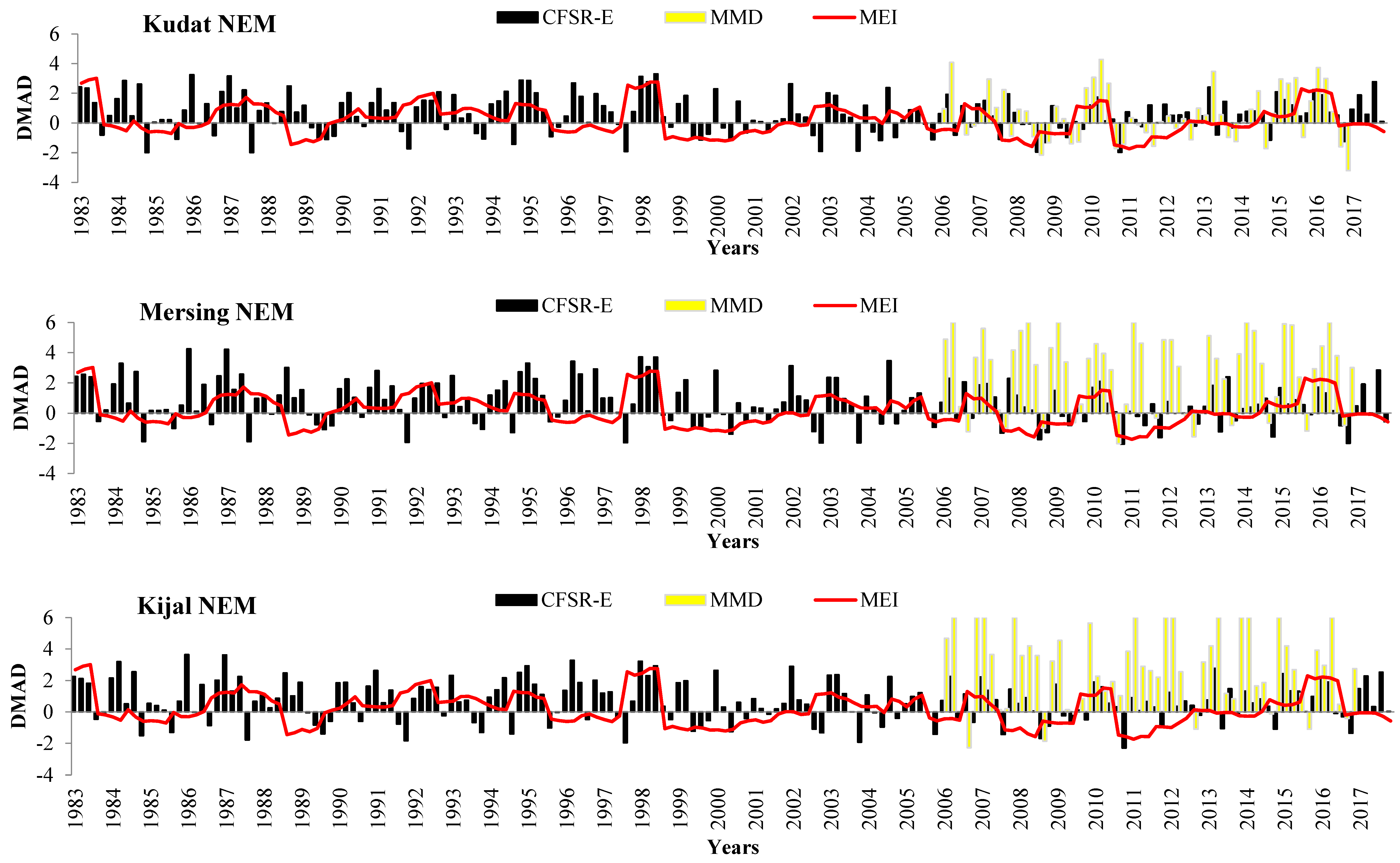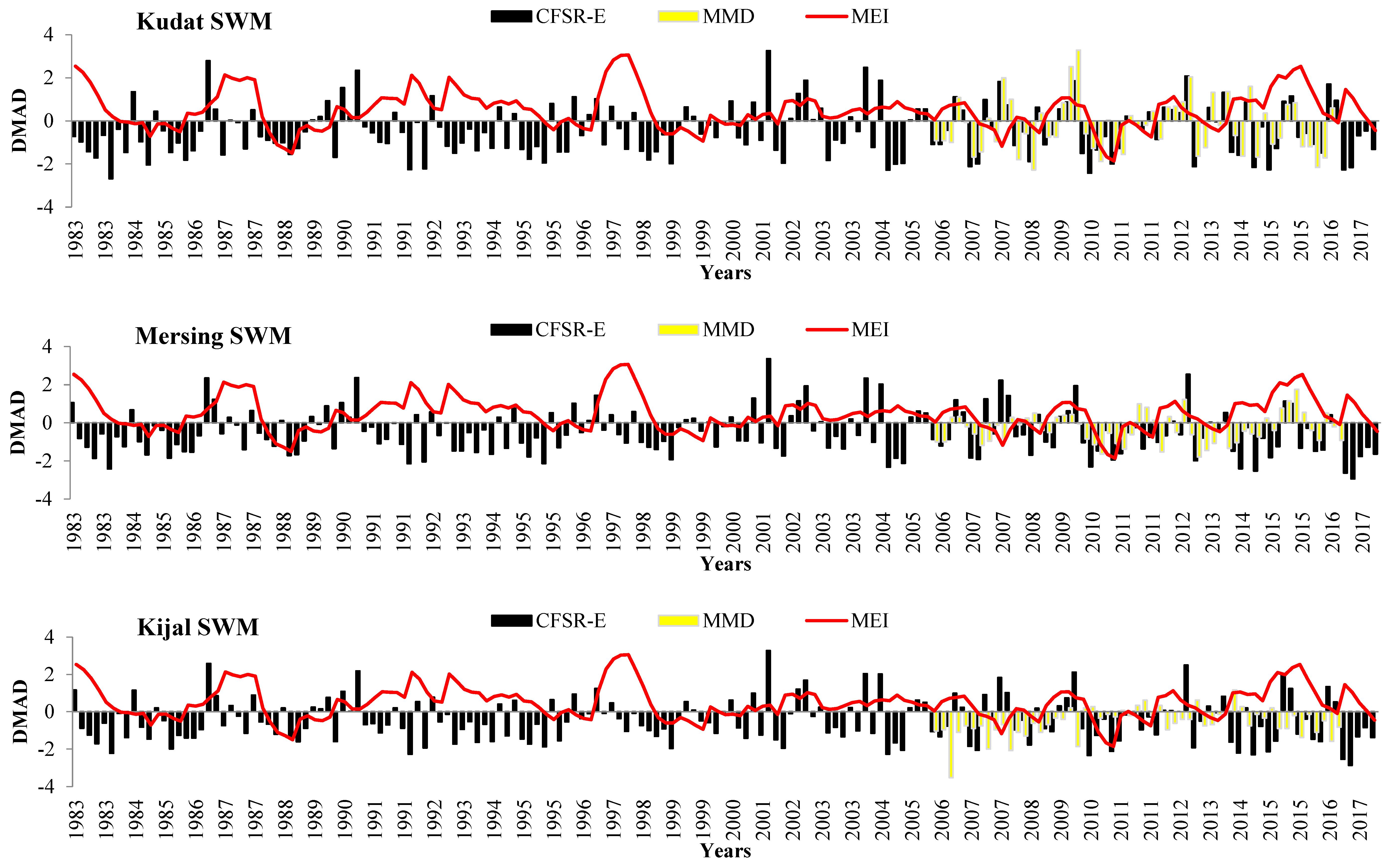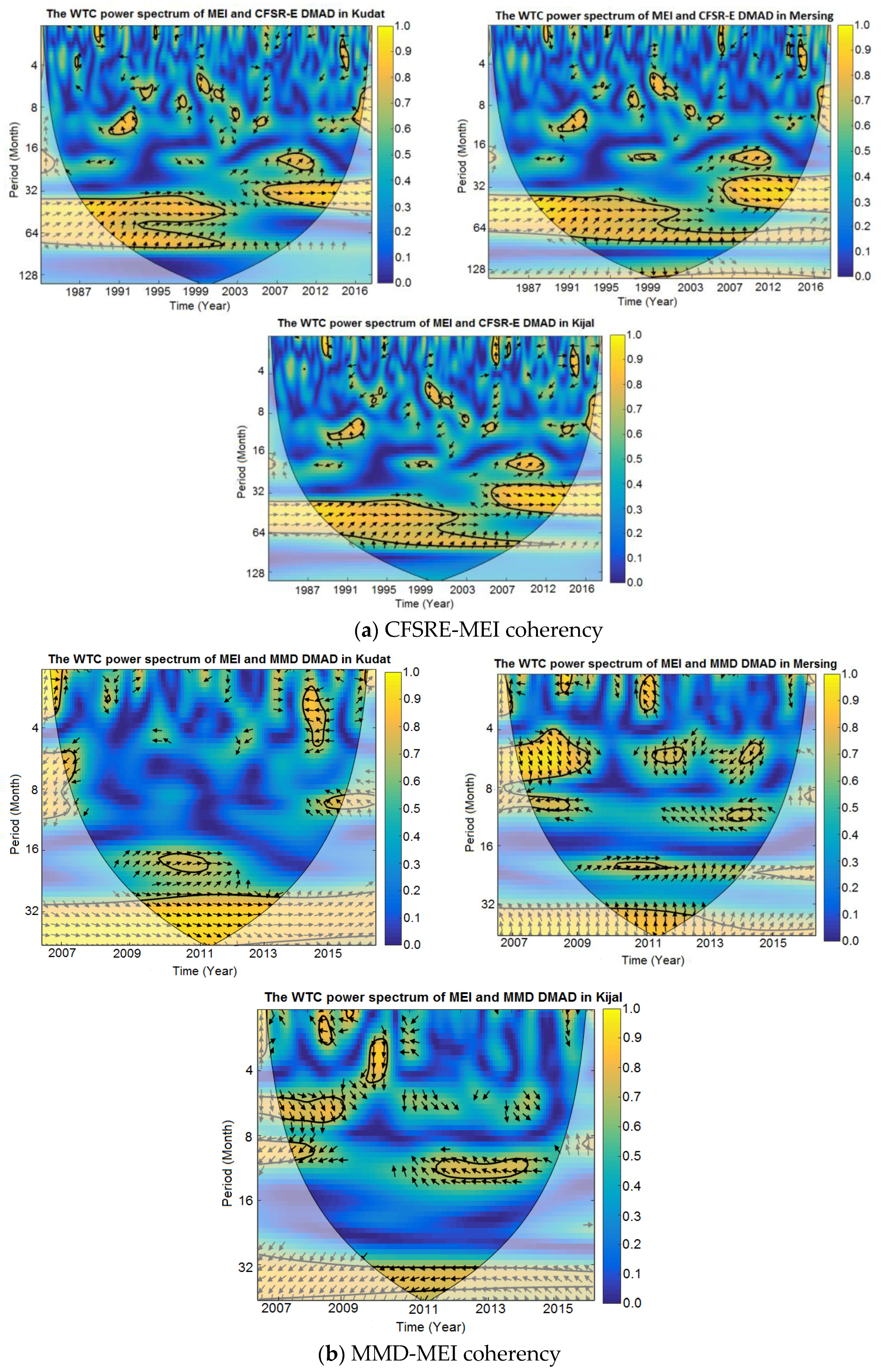Influence of the ENSO and Monsoonal Season on Long-Term Wind Energy Potential in Malaysia
Abstract
:1. Introduction
2. Method and Materials
2.1. Data Description
2.2. Wavelet Coherence
2.3. Vertical Extrapolation
2.4. Energy Production
2.5. Accuracy Metrics
2.5.1. The Coefficient of Determination
2.5.2. The Root Mean Square Error
2.5.3. Mean Absolute Error
3. Results and Discussion
3.1. The Variability of CFSRE and MMD Data
3.2. The Wind Speed Prediction
3.3. Long Term Wind Energy Potential
4. Conclusions and Recommendation
- The influences of ENSO on the wind speed pattern of selected sites were assessed using the DMAD method during the Southwest monsoon (SWM) and Northeast monsoon (NEM). During the NEM season, both CFSRE and MMD for all sites show an increment in wind speed from their median levels, while a decrement occurred during the SWM season.
- The wavelet coherency analysis is useful to study the interaction and the relative phase between two time series. The relationships between wind speed and MEI time series data showed the strongest correlation at around the 32–64 months period band for CFSRE-MEI and above 31 months for MMD-MEI coherency.
- Long-term wind energy production was determined by averaging the 35 years (MCP-CFSRE) and 10 years (MCP-MMD) of computed capacity factor (CF). The averaged CF during the NEM was higher compared to the SWM for Kijal and Mersing. In Kijal the average CF is 10.66% during the NEM and 5.19% during the SWM, while the average CF in Mersing during NEM and SWM are 21.32% and 3.71% respectively. However, the result is different for Kudat where the monthly CF is almost the same for both the SWM and NEM season. The average CF at Kudat during the SWM (36.42%) is slightly higher compared to the NEM (24.61%).
- The ENSO (MEI index) has an influence on the variability of wind speed (CFSRE and MMD) in Malaysia, which also directly affects the projected energy production.
Author Contributions
Funding
Acknowledgments
Conflicts of Interest
Abbreviations
| CFSRE | Extended Climate Forecast System Reanalysis |
| DMAD | Dimensionless Median Absolute Deviation |
| ENSO | El Niño Southern Oscillation |
| MEI | Multivariate ENSO Index |
| MMD | Malaysia Meteorological Department |
| NEM | Northeast Monsoon |
| SWM | Southwest Monsoon |
References
- Albani, A.; Ibrahim, M.Z. An assessment of wind energy potential for selected sites in Malaysia using feed-in tariff criteria. Wind Eng. 2014, 38. [Google Scholar] [CrossRef]
- Ibrahim, M.Z.; Albani, A. The potential of wind energy in Malaysian renewable energy policy: Case study in kudat, sabah. Energy Environ. 2014, 25. [Google Scholar] [CrossRef]
- Albani, A.; Ibrahim, M.Z. Wind Energy Potential and Power Law Indexes Assessment for Selected Near-Coastal Sites in Malaysia. Energies 2017, 10, 307. [Google Scholar] [CrossRef]
- Muzathik, A.M.; Nik Wan, W.B.; Ibrahim, M.Z.; Samo, K.B. Wind resource investigation of Terengganu in the west Malaysia. Wind Eng. 2009, 33, 389–402. [Google Scholar] [CrossRef]
- Landberg, L.; Myllerup, L.; Rathmann, O.; Petersen, E.L.; Jørgensen, B.H.; Badger, J.; Mortensen, N.G. Wind resource estimation—An overview. Wind Energy 2003, 6, 261–271. [Google Scholar] [CrossRef]
- Weekes, S.M.; Tomlin, A.S.; Vosper, S.B.; Skea, A.K.; Gallani, M.L.; Standen, J.J. Long-term wind resource assessment for small and medium-scale turbines using operational forecast data and measure-correlate-predict. Renew. Energy 2015, 81, 760–769. [Google Scholar] [CrossRef]
- Bueno, C.; Carta, J.A. Wind powered pumped hydro storage systems, a means of increasing the penetration of renewable energy in the Canary Islands. Renew. Sustain. Energy Rev. 2006, 10, 312–340. [Google Scholar] [CrossRef]
- Zelle, H.; Appeldoorn, G.; Burgers, G.; van Oldenborgh, G.J. The Relationship between Sea Surface Temperature and Thermocline Depth in the Eastern Equatorial Pacific. J. Phys. Oceanogr. 2004, 34, 643–655. [Google Scholar] [CrossRef] [Green Version]
- Agilan, V.; Umamahesh, N.V. Detection and attribution of non-stationarity in intensity and frequency of daily and 4-h extreme rainfall of Hyderabad, India. J. Hydrol. 2015, 530, 677–697. [Google Scholar] [CrossRef]
- Wolter, K.; Timlin, M.S. Measuring the strength of ENSO events: How does 1997/98 rank? Weather 1998, 53, 315–324. [Google Scholar] [CrossRef]
- Mohammadi, K.; Goudarzi, N. Study of inter-correlations of solar radiation, wind speed and precipitation under the influence of El Niño Southern Oscillation (ENSO) in California. Renew. Energy 2018, 120, 190–200. [Google Scholar] [CrossRef]
- Watts, D.; Durán, P.; Flores, Y. How does El Niño Southern Oscillation impact the wind resource in Chile? A techno-economical assessment of the influence of El Niño and La Niña on the wind power. Renew. Energy 2017, 103, 128–142. [Google Scholar] [CrossRef]
- Hamlington, B.D.; Hamlington, P.E.; Collins, S.G.; Alexander, S.R.; Kim, K.Y. Effects of climate oscillations on wind resource variability in the United States. Geophys. Res. Lett. 2015, 42, 145–152. [Google Scholar] [CrossRef] [Green Version]
- IEC. IEC61400-12-1 Wind Turbines-Part 12-1: Power Performance Measurement of Electricity Producing Wind Turbines, 1st ed.; IEC: Geneva, Switzerland, 2005. [Google Scholar]
- Ibrahim, M.Z.; Yong, K.H.; Ismail, M.; Albani, A.; Muzathik, A.M. Wind characteristics and gis-based spatial wind mapping study in Malaysia. J. Sustain. Sci. Manag. 2014, 9, 1–20. [Google Scholar]
- Ibrahim, M.Z.; Yong, K.H.; Ismail, M.; Albani, A. Spatial Analysis of Wind Potential for Malaysia. Int. J. Renew. Energy Res. 2015, 5, 202–209. [Google Scholar]
- Ibrahim, M.Z.; Albani, A. Wind turbine rank method for a wind park scenario. World J. Eng. 2016, 13, 500–508. [Google Scholar] [CrossRef]
- Albani, A.; Ibrahim, M.; Yong, K. The feasibility study of offshore wind energy potential in Kijal, Malaysia: The new alternative energy source exploration in Malaysia. Energy Explor. Exploit. 2014, 2. [Google Scholar] [CrossRef]
- IEA. IEA Recommendation 11: Wind Speed Measurement and Use of Cup Anemometry; IEA: Paris, France, 1999. [Google Scholar]
- Wettayaprasit, W.; Laosen, N.; Chevakidagarn, S. Data filtering technique for neural network forecasting. In Proceedings of the 7th WSEAS International Conference on Simulation, Modelling and Optimization, Beijing, China, 15–17 September 2007. [Google Scholar]
- Mueller, P.K.; Watson, J.G. Eastern Regional Air Quality Measurements; Environmental Research and Technology, Inc.: Concord, MA, USA, 1982; Volume 1, Available online: https://www.osti.gov/biblio/6730513-eastern-regional-air-quality-measurements-volume-final-report (accessed on 1 December 2017).
- Watson, J.G.; Lioy, P.J.; Mueller, P.K. The measurement process: Precision, accuracy, and validity. In Air Sampling Instruments for Evaluation of Atmospheric Contaminants, 7th ed.; Hering, S.V., Ed.; American Conference of Governmental Industrial Hygienists: Cincinnati, OH, USA, 1989; pp. 51–57. [Google Scholar]
- NCAR. The Climate Data Guide: Climate Forecast System Reanalysis (CFSR). Natl Cent Atmos Res Staff n.d. Available online: https://climatedataguide.ucar.edu/climate-data/climate-forecast-system-reanalysis-cfsr (accessed on 3 October 2016).
- Sharp, E.; Dodds, P.; Barrett, M.; Spataru, C. Evaluating the accuracy of CFSR reanalysis hourly wind speed forecasts for the UK, using in situ measurements and geographical information. Renew. Energy 2015, 77, 527–538. [Google Scholar] [CrossRef]
- Carta, J.A.; Velazquez, S.; Cabrera, P. A review of measure-correlate-predict (MCP) methods used to estimate long-term wind characteristics at a target site. Renew. Sustain. Energy Rev. 2013, 27, 362–400. [Google Scholar] [CrossRef]
- Liléo, S.; Petrik, O. Investigation on the use of NCEP/NCAR, MERRA and NCEP/CFSR reanalysis data in wind resource analysis. In Proceedings of the European Wind Energy Conference and Exhibition, Brussels, Belgium, 14–17 March 2011. [Google Scholar]
- Yeo, S.R.; Kim, K.Y. Global warming, low-frequency variability, and biennial oscillation: An attempt to understand the physical mechanisms driving major ENSO events. Clim. Dyn. 2014, 43, 771–786. [Google Scholar] [CrossRef]
- Victor, C.C.; Ling, H. Time-Frequency Transforms for Radar Imaging and Signal Analysis; Artech House: Boston, MA, USA; London, UK, 2002. [Google Scholar]
- Chellali, F.; Khellaf, A.; Belouchrani, A. Wavelet spectral analysis of the temperature and wind speed data at Adrar, Algeria. Renew. Energy 2010, 35, 1214–1219. [Google Scholar] [CrossRef]
- Torrence, C.; Compo, G.P. A Practical Guide to Wavelet Analysis. Bull. Am. Meteorol. Soc. 1998, 79, 61–78. [Google Scholar] [CrossRef] [Green Version]
- Zhang, J.; Draxl, C.; Hopson, T.; Monache, L.D.; Vanvyve, E.; Hodge, B.M. Comparison of numerical weather prediction based deterministic and probabilistic wind resource assessment methods. Appl. Energy 2015, 156, 528–541. [Google Scholar] [CrossRef] [Green Version]
- Jung, S.; Arda Vanli, O.; Kwon, S.-D. Wind energy potential assessment considering the uncertainties due to limited data. Appl. Energy 2013, 102, 1492–1503. [Google Scholar] [CrossRef]
- Kidmo, D.K.; Doka, S.Y.; Danwe, R.; Djongyang, N. Performance Analysis of Weibull Methods for Estimation of Wind Speed Distributions in the Adamaoua Region of Cameroon. Int. J. Basic Appl. Sci. 2014, 3, 298–306. [Google Scholar] [CrossRef]
- Chai, T.; Draxler, R.R. Root mean square error (RMSE) or mean absolute error (MAE)?-Arguments against avoiding RMSE in the literature. Geosci. Model Dev. 2014, 7, 1247–1250. [Google Scholar] [CrossRef]
- Azad, A.K.; Rasul, M.G.; Yusaf, T. Statistical Diagnosis of the Best Weibull Methods for Wind Power Assessment for Agricultural Applications. Energies 2014, 7, 3056–3085. [Google Scholar] [CrossRef] [Green Version]
- Costa Rocha, P.A.; Coelho de Sousa, R.; Freitas de Andrade, C.; Vieira da Silva, M. Comparison of Seven Numerical Methods for Determining Weibull Parameters for Wind Energy Generation in the Northeast Region of Brazil. Appl. Energy 2012, 89, 395–400. [Google Scholar] [CrossRef]
- Willmott, C.J.; Matsuura, K. Advantages of the mean absolute error (MAE) over the root mean square error (RMSE) in assessing average model performance. Clim. Res. 2005, 30, 79–82. [Google Scholar] [CrossRef] [Green Version]
- Albani, A. Statistical Analysis of Wind Power Density Based on the Weibull and Rayleigh Models of Selected Site in Malaysia. Pak. J. Stat. Oper. Res. 2013, 9, 393–406. [Google Scholar] [CrossRef]
- Albani, A.; Ibrahim, M.Z.; Taib, C.M.I.C.; Azlina, A.A. The optimal generation cost-based tariff rates for onshore wind energy in Malaysia. Energies 2017, 10, 1114. [Google Scholar] [CrossRef]
- Mazzarella, A.; Giuliacci, A. Adriano Mazzarella The El Niño events their classification. Ann. Geophys. 2009, 52, 517–522. [Google Scholar]
- Rogers, A.L.; Rogers, J.W.; Manwell, J.F. Comparison of the performance of four measure-correlate-predict algorithms. J. Wind Eng. Ind. Aerodyn. 2005, 93, 243–264. [Google Scholar] [CrossRef]
- Derrick, A. Development of the measure-correlate-predict strategy for site assessment. In Proceedings of the 14th British Wind Energy Association Annual Conference, Nottingham, UK, 25–27 March 1992; pp. 259–265. [Google Scholar]
- Woods, J.C.; Watson, S.J. A new matrix method of predicting long-term wind roses with MCP. J. Wind Eng. Ind. Aerodyn. 1997, 66, 85–94. [Google Scholar] [CrossRef]
- Mortimer, A. A new correlation/prediction method for potential wind farm sites. In Proceedings of the Bwea Wind Energy Conference, Sterling, UK, 15–17 June 1994; p. 1994. [Google Scholar]
- Ross, S. Introduction to Probability and Statistics for Engineers and Scientists; John Wiley & Sons: Hoboken, NJ, USA, 1987. [Google Scholar]
- Thøgersen, M.L.; Nielsen, P.; Sørensen, T.; Svenningsen, L.U. An Introduction to the MCP Facilities in WindPRO. EMD International A/S 2010. Available online: http://help.emd.dk/knowledgebase/ content/ReferenceManual/MCP.pdf (accessed on 1 January 2018).
- Statstutor. Spearman’s Correlation n.d. Available online: http://www.statstutor.ac.uk/resources/uploaded/spearmans.pdf (accessed on 10 September 2018).
- Wirachai, R. The Combination of Small and Megawatt Wind Machine in Wind Farm Design for Low Wind Speed Zones. In Proceedings of the Asia Pacific Economic Corporation (APEC) Seminar Best Practices of Wind Energy Development in the APEC Region, Lima, Peru, 4–5 October 2016. [Google Scholar]
- Wang, G.; Su, J.; Ding, Y.; Chen, D. Tropical cyclone genesis over the south China sea. J. Mar. Syst. 2007, 68, 318–326. [Google Scholar] [CrossRef]






| Data | Information | Kudat | Mersing | Kijal |
|---|---|---|---|---|
| Wind mast data | Coordinates | 7°1′45.33″ N 116°44′47.98″ E | 2°34′50.00″ N 103°48′23.60″ E | 4°20′50.70″ N 103°28′34.74″ E |
| Height | 10 m, 70 m | 10 m, 60 m | 10 m, 60 m | |
| Power law index (PLI) | 0.38 | 0.20 | 0.25 | |
| Period | May 2014–April 2015 (12 Months) 52,560 data Recovery: 99% | January 2014–December 2014 (12 Months) 52,560 data Recovery: 99% | May 2013–April 2014 (12 Months) 52,560 data Recovery: 99% | |
| MMD data | Coordinates | 6°55′12.00″ N 116°49′48.00″ E | 2°27′0.00″ N 103°49′48.00″ E | 5°22′48.00″ N 103°5′60.00″ E |
| Height | 10 m | 10 m | 10 m | |
| Period | 1 January 2006–December 2016 | 1 January 2006–December 2016 | 1 January 2006–December 2016 | |
| CFSRE data | Coordinates | 7°0′0.00″ N 117°0′0.00″ E | 2°30′0.00″ N 103°59′60.00″ E | 4°0′0.00″ N 103°29′60.00″ E |
| Height | 10 m | 10 m | 10 m | |
| Period | 1 January 1983–31 December 2017 | 1 January 1983–31 December 2017 | 1 January 1983–31 December 2017 |
| Site | Metrics | CFSRE | MMD | MCP-MMD | MCP-CFSRE |
|---|---|---|---|---|---|
| Kudat | r | 0.4532 | 0.2538 | 0.1879 | 0.4174 |
| MAE | 1.0518 | 1.1389 | 1.1664 | 1.0899 | |
| RMSE | 2.0815 | 1.8510 | 2.0767 | 1.6676 | |
| Mersing | r | 0.4610 | 0.3861 | 0.3788 | 0.4303 |
| MAE | 1.2748 | 1.3233 | 1.3232 | 1.2886 | |
| RMSE | 1.9503 | 1.7871 | 1.9046 | 1.8219 | |
| Kijal | r | 0.5481 | 0.5161 | 0.4445 | 0.4599 |
| MAE | 1.0019 | 1.0410 | 1.0788 | 1.0729 | |
| RMSE | 1.8376 | 1.3759 | 1.6182 | 1.5275 |
| Site | Data | Signal | Mean | Weibull Mean | Weibull Scale, c | Weibull Shape, k |
|---|---|---|---|---|---|---|
| Kudat | CFSRE Concurrent | Mean wind speed, m/s | 3.76 | 3.81 | 4.30 | 2.12 |
| Wind direction, Degrees | 106.20 | - | - | - | ||
| MMD Concurrent | Mean wind speed, m/s | 2.52 | 2.72 | 3.07 | 2.07 | |
| Wind direction, Degrees | 156.8 | - | - | - | ||
| Mast | Mean wind speed, m/s | 2.82 | 2.85 | 3.21 | 1.84 | |
| Wind direction, Degrees | 171.10 | - | - | - | ||
| MCP-CFSRE Concurrent | Mean wind speed, m/s | 2.77 | 2.85 | 3.22 | 2.05 | |
| Wind direction, Degrees | 175.20 | - | - | - | ||
| MCP-MMD Concurrent | Mean wind speed, m/s | 2.93 | 3.03 | 3.43 | 1.99 | |
| Wind direction, Degrees | 198.00 | - | - | - | ||
| Mersing | CFSRE | Mean wind speed, m/s | 3.36 | 3.41 | 3.84 | 2.38 |
| Wind direction, Degrees | 111.40 | - | - | - | ||
| MMD | Mean wind speed, m/s | 2.83 | 2.97 | 3.36 | 2.28 | |
| Wind direction, Degrees | 268.40 | - | - | - | ||
| Mast | Mean wind speed, m/s | 2.43 | 2.59 | 2.90 | 1.67 | |
| Wind direction, Degrees | 164.40 | - | - | - | ||
| MCP-CFSRE | Mean wind speed, m/s | 2.45 | 2.60 | 2.92 | 1.75 | |
| Wind direction, Degrees | 133.30 | - | - | - | ||
| MCP-MMD | Mean wind speed, m/s | 2.49 | 2.63 | 2.96 | 1.78 | |
| Wind direction, Degrees | 174.40 | - | - | - | ||
| Kijal | CFSRE | Mean wind speed, m/s | 3.36 | 3.40 | 3.83 | 2.19 |
| Wind direction, Degrees | 22.8 | - | - | - | ||
| MMD | Mean wind speed, m/s | 2.09 | 2.34 | 2.65 | 2.14 | |
| Wind direction, Degrees | 149.9 | - | - | - | ||
| Mast | Mean wind speed, m/s | 2.31 | 2.47 | 2.77 | 1.76 | |
| Wind direction, Degrees | 20.2 | - | - | - | ||
| MCP-CFSRE | Mean wind speed, m/s | 2.26 | 2.37 | 2.67 | 1.82 | |
| Wind direction, Degrees | 330.00 | - | - | - | ||
| MCP-MMD | Mean wind speed, m/s | 2.34 | 2.44 | 2.74 | 1.71 | |
| Wind direction, Degrees | 329.6 | - | - | - |
| Data | Composition | Kudat | Mersing | Kijal |
|---|---|---|---|---|
| MCP-CFSRE (35-years) | Average CF (%); NEM + SWM | 30.56 | 11.49 | 7.24 |
| Average CF (%); NEM only | 24.61 | 21.32 | 10.66 | |
| Average CF (%); SWM only | 36.42 | 3.71 | 5.19 | |
| MCP-MMD (10 years) | Average CF (%); NEM + SWM | 30.25 | 11.75 | 11.93 |
| Average CF (%); NEM only | 23.57 | 18.14 | 16.20 | |
| Average CF (%); SWM only | 35.79 | 7.92 | 8.73 |
© 2018 by the authors. Licensee MDPI, Basel, Switzerland. This article is an open access article distributed under the terms and conditions of the Creative Commons Attribution (CC BY) license (http://creativecommons.org/licenses/by/4.0/).
Share and Cite
Albani, A.; Ibrahim, M.Z.; Yong, K.H. Influence of the ENSO and Monsoonal Season on Long-Term Wind Energy Potential in Malaysia. Energies 2018, 11, 2965. https://doi.org/10.3390/en11112965
Albani A, Ibrahim MZ, Yong KH. Influence of the ENSO and Monsoonal Season on Long-Term Wind Energy Potential in Malaysia. Energies. 2018; 11(11):2965. https://doi.org/10.3390/en11112965
Chicago/Turabian StyleAlbani, Aliashim, Mohd Zamri Ibrahim, and Kim Hwang Yong. 2018. "Influence of the ENSO and Monsoonal Season on Long-Term Wind Energy Potential in Malaysia" Energies 11, no. 11: 2965. https://doi.org/10.3390/en11112965
APA StyleAlbani, A., Ibrahim, M. Z., & Yong, K. H. (2018). Influence of the ENSO and Monsoonal Season on Long-Term Wind Energy Potential in Malaysia. Energies, 11(11), 2965. https://doi.org/10.3390/en11112965






